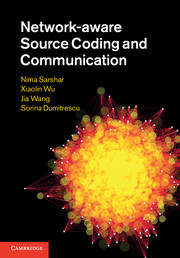3 - Lossless multicast of multiple uncorrelated sources
from Part I - The lossless scenario
Published online by Cambridge University Press: 07 October 2011
Summary
In the previous chapter, we reviewed the problem of lossless multicast when there is only one information source in the network. In many practical applications, however, there is more than one information source, each with its intended set of clients. One might be interested in the maximum rate of information that can be communicated from each source to its intended clients. Unlike the case with only one information source, the problem becomes involved even when each source has only one intended client, a case called multi-unicast problem. Even then, optimum communication strategies and the set of achievable information rates are not known in general. We will review some of the known results for the multi-unicast problem.
Multi-unicast problem
We start with the multiple unicast, or multi-unicast, problem. Materials in this section are mainly a summary of the results in [17, 18]. The readers are referred to these works for further reading. The multi-unicast communication problem with k sources is defined as follows: A graph G = 〈V, E〉 and k pairs of vertices {(s1; t1); (s2; t2) … (sk; tk)} are given. Each source si is assumed to have access to an independent information source that it wishes to communicate to its intended receiver ti. A demand vector of rates r = (r1, r2, …, rk) is said to be achievable if a communication strategy can be found to simultaneously communicate information with rate ri from si to ti for all i = 1, 2, 3, …, k.
- Type
- Chapter
- Information
- Network-aware Source Coding and Communication , pp. 20 - 24Publisher: Cambridge University PressPrint publication year: 2011



